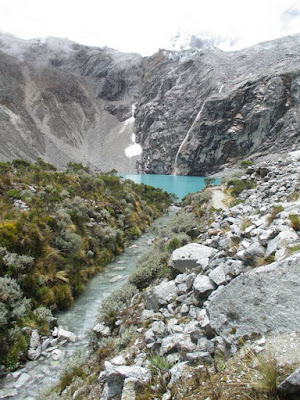 |
| Pico Bolivar, Venezuela, comparison of 1950 to 2011. Photo: Wikimedia Commons |
In a recent article in NotiSur, we covered the effects of climate change in Bolivia. According to the piece written by Andrés Gaudín, Bolivian President, Evo Morales has demonstrated a strong dedication to combattig climate change, as his country has suffered a disproportionate impact from the warming of the climate, as evidenced by extended dry conditions over the past several years.
Morales is fighting an uphill battle. The combination of a persistent drought and the alarming rate at which Andean glaciers are melting threatens the livelihoods of millions of Bolivians. The increasing scarcity of water in the region makes subsistence farming an increasingly precarious existence.
Access to water is an issue that is relevant across the globe (including the US, where a proposed fuel pipeline in the state of North Dakota could threaten to pollute local water supplies). The Andes containing 99% of the world’s tropical glaciers, and a large percentage of these ice formations are in decline. This has prompted a myriad of studies by scientists hoping to find some sort of response to the ever-growing threat to the local water supplies. One of the threatened areas is Cordillera Blanca of Peru, where researchers from Syracuse University are trying to understand how the loss of glaciers has put local water supplies under pressure. According to one of the Syracuse studies, Peruvian glaciers have lost nearly half of their surface area since 1970. Laura Lautz, an associate professor of earth sciences at the university is trying to determine how glacial erosion has had an impact on reducing flows of rivers and streams in the region. Few other studies have been conducted on the topic because the remote nature of the region, which has made access difficult.
 |
| Photo: Sabrina Hernández |
The lack of access to the rugged Andean terrain is one reason why the border between Ecuador and Peru remains a point of contention. In 2011 we published an article in NotiSur on the Ecuadoran government’s decision to implement large-scale extractive-mining projects in the southeastern part of the country, even though these lands had been demarcated as “intangible” because of their great biological diversity or because of their being a source of water for nearby populations. This area has generated ongoing conflicts as both Peru and Ecuador seek claim to this region because of large deposits of gold, copper, and uranium. Mining has proven disastrous for the environment as it destroys high wetland pastures, dries up water sources, and completely alters the mountain landscape by removing mountain tops.
Chile, a country that is home to a large chunk of the Andean chain (though not considered geopolitically an Andean state), also sees its glaciers threatened by mining. The country is home to approximately 82% of South America’s glaciers and relies on these icepacks as a source of fresh water.
Chile has recently experienced drier-than-average weather, leading the government to issue official water- shortage declarations. The unusually dry weather and shortage of water has led many to search for both short- and long-term solutions also and to consider the importance of protecting glaciers and the fresh water they provide. Mining is just one threat that Chilean glaciers face and efforts have been made to thwart proposed multi-billion-dollar mining projects in the region.
While governments and NGOs look for solutions to glacial erosion and water shortages, another effect of climate change is the loss of cultural practices and traditional homelands for the predominantly Quechua-speaking Andean inhabitants. Not only are farmers being forced higher up mountainsides by warmer weather, but theirs is a culture that views the Andean peaks as protective deities. Mountains that once were covered in glaciers now show bare rock.
This glacial erosion also hurts employment in the tourism industry, as many tourist trails have now been rendered unsafe because of snow melt. There is strong concern that the disappearance of the snow will also result in the disappearance of local communities.
No comments:
Post a Comment